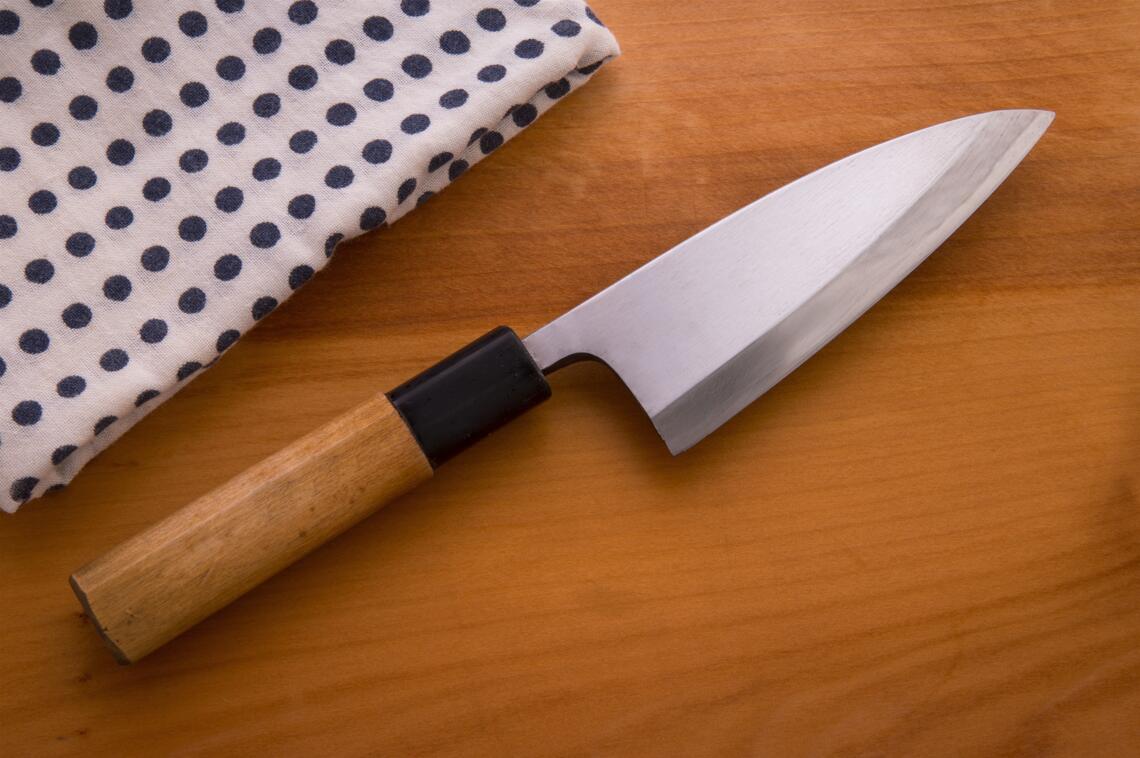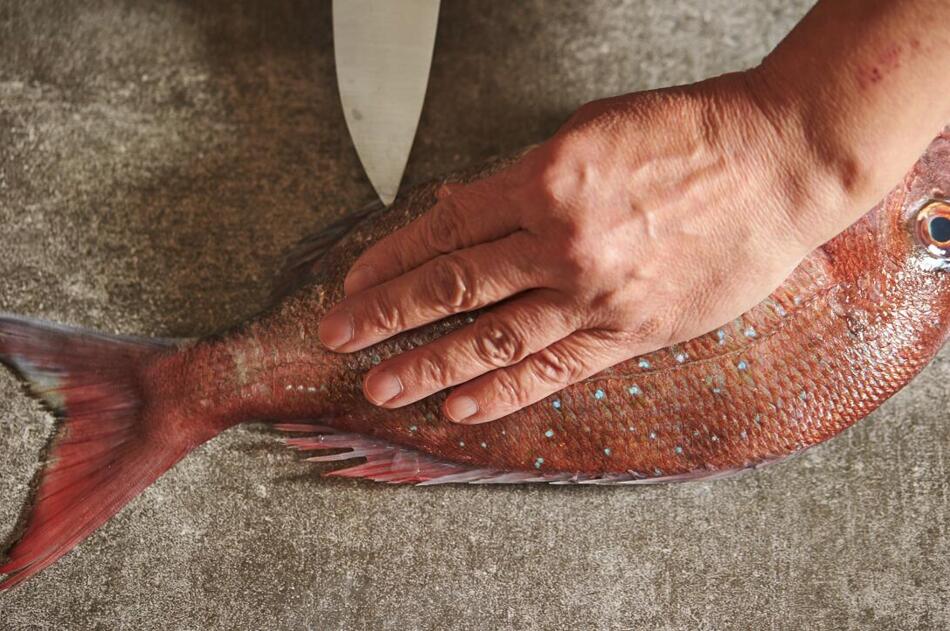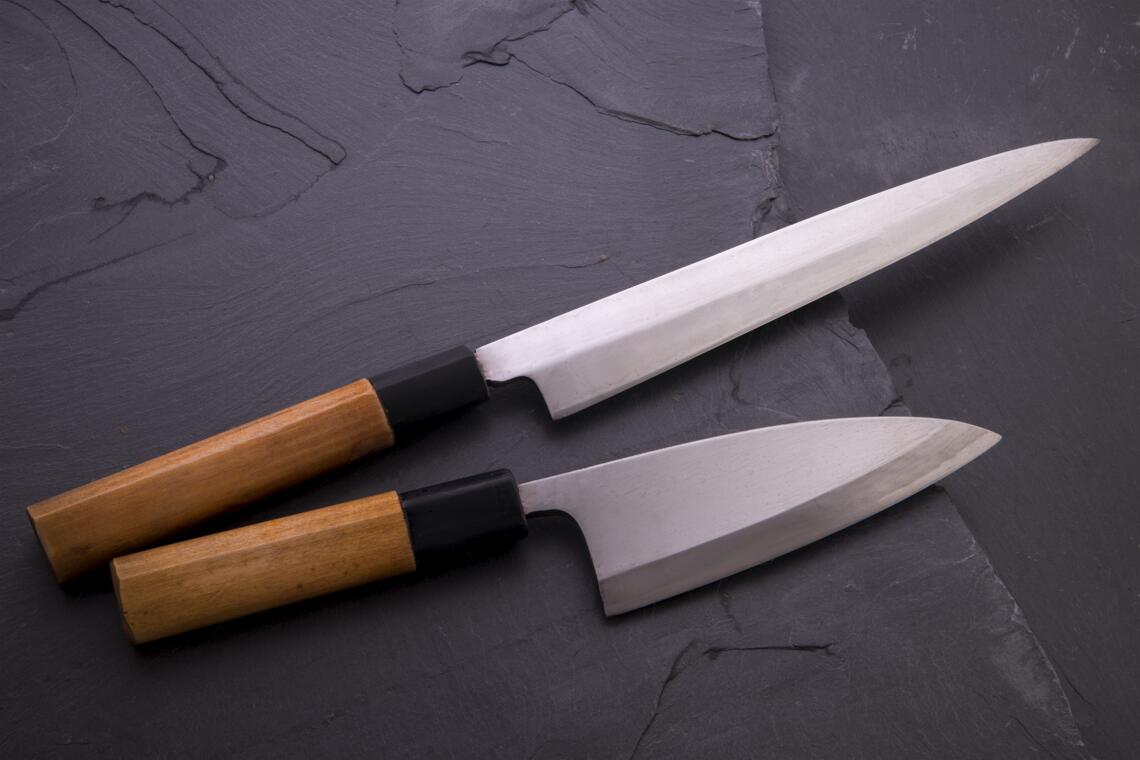Filleting fish is a difficult skill to master—requiring both the highest levels of dexterity and finesse. However, a good fillet knife can take much of the guesswork out of the process. Among the best fillet knives available, those manufactured in Japan represent the pinnacle of knife-making expertise.
A masterfully crafted Japanese fillet knife has an unparalleled cutting ability. These knives come in different blade sizes and styles, fine-tuned to produce the most delicate fillets. Although they differ in grind, flexibility, thickness, and curvature of the blade, they all share the same core feature—a precise, thin cutting edge.
This article will discuss the features of different Japanese fillet knives, their uses, and what to look for when choosing the right fit for you. You’ll also learn the differences between Japanese and Western fillet knives.
Table of contents
What is a Japanese fillet knife?
A Japanese fillet knife is a carving knife used for slicing fish fillets. The blade features a long, thin, flexible body that separates flesh from bone with minimal waste. In most cases, chefs use the blade’s full length for slicing in a technique that involves curving the arm while drawing the knife along the fish, using even pressure to cover maximum ground with each cut.
The knives measure from 6 to 11 inches in length and resemble short swords with pointed tips. The design material is stainless steel, but some Japanese fillet knives feature carbon steel, tool steel, or an alloy of both. Most knives feature a single bevel, but some have a double bevel.
The most common Japanese fillet knife is the Deba.
What’s Deba?

Deba, a Japanese dialect translated as “Short Fat Tooth” to describe its unique shark-shaped blade, is one of the most popular Japanese fillets knives. It features a thick grind that adds strength to its blade while maintaining its ability to hold an edge. Deba knives measure between 6 to 12 inches, making them one of the most compact Japanese fillets knives available.
Chefs recommend an 8 inch Deba for its balance, maneuverability, and power. As with most Japanese kitchen knives, the Deba knife is also single beveled. Its razor-sharp edge combined with the significant weight of its body delivers precise cuts through fish with smooth, clean strokes.
Filleting fish isn’t the only thing the Deba knife is good for. Chefs use it for the entire fish processing process, from scaling to gutting. Its thick spine makes it ideal for removing the head, while the thick spine allows for filleting the fish without damaging the delicate flesh. It’s also great for breaking down poultry with tiny bones and nimble joints, but a HDMD Serbian chef knife will be a great option for anything tougher than that.
Features and design of the Deba knife
The Deba knife comes in different lengths and styles. Unlike its Western counterpart, the Japanese fillet knife has a thick blade that ranges from 5 to 9 millimeters in thickness. The blades also come in various sizes, each with their benefits for fish processing.
Other features and design of the Deba knife include:
- Single beveled: The Deba knife is single-beveled, as are most Japanese fillet knives. It features a symmetrical edge that comes to an extremely sharp point.
- Chisel ground blade: The blade features a chisel grind that creates a sharp edge with an acute point.
- The blade tapers towards the cutting edge: It creates a larger contact surface at the blade’s hilt, preventing it from slipping.
- Features a thick spine: The thick spine on the Deba knife adds weight to its body, making it ideal for breaking down large fish.
- Extremely sharp edge: The sharp edge provides clean cuts with minimal effort, making it a favorite among chefs.
- Designed with stainless steel: The razor-sharp chisel grind features a stainless steel blade that resists corrosion.
Types of Deba knives
There are different types of Deba knives, which vary in size and configuration.
- Hon-Deba: It’s the thickest and heaviest of all the Deba knives. It features a thick blade and extra weight for slicing through dense bones and small chunks of meat, something most Deba knives can’t handle efficiently.
- Ko-Deba: The Ko-Deba is a versatile, light fillet knife. It’s smaller and most suitable when working with smaller fish.
- Kanisaki-Deba: The Kanisaki is a small Deba commonly used when working with Oysters and Lobsters
- Miroshi Deba: The Miroshi Deba is a longer, thinner, and flexible Deba notable for its ability to fillet large fish.
Other Japanese fillet knives

While the Deba knife is the most popular Japanese fillet knife, different knives ideal for fish filleting are available.
Yanagiba
The Yanagiba knife is a traditional Japanese knife primarily used to slice raw fish. It’s single-beveled, flexible, and thin, making it an ideal choice for chefs looking to fillet small to medium-sized fish. It measures between 10 to 14 inches and features a razor-sharp edge that smoothly glides through fish.
Sujihiki
The Sujihiki is one of the most versatile knives for filleting fish. It’s single-beveled, long, and slim, making it easy to maneuver through different filleting angles. Chefs also use the Sujihiki for slicing and carving meat and poultry.
How to Use the Deba knife
Properly handling a Deba knife requires following proper techniques to prevent injuries. Achieving the finest fillets cuts starts with establishing the correct grip. The proper grip ensures a clean cut for the fillet.
How to correctly grip a Deba knife
Handling the Deba knife is different from how you hold a kitchen knife. The Deba’s weight and size require a different grip.
Follow the steps below to grip the Deba knife properly.
- First, open the palm of your hand and grip the handle with three fingers. Move the middle finger as close to the blade as possible.
- Place the pointing finger on the blade’s spine just above the bolster for extra control. Avoid bending the pointing finger on the spine of the blade.
- The thumb rests on the side of the blade close to the heel. Give your knuckles a little flex and keep your hand relaxed.
- For smaller Deba knives, let the three fingers grip the handle without being overly close to the blade. The pointing finger can bend a little on the blade but still give you a firm grip. The thumb rests on the side of the blade while maintaining a flat grip for extra control over the knife.
Proper use of a Deba knife
The proper use of the Deba knife involves three types of cuts: filleting, slicing, and skinning.
Filleting
Filleting is the process of removing meat from the bone. Let the Deba knife do the work and cut along the bones. The filleting process starts with removing the head of the fish. This process involves using the tip of the knife against the head of the fish.
Pull the fin behind the head of the fish and cut through right where it meets the head. Follow this by making a shallow cut along the spine at an angle that matches where you’re cutting, all while avoiding the fish’s spine. Once the fish’s flesh is exposed, run your blade along with the bones in a gentle fashion until you reach the fish’s tail. Gently pull off any remaining meat at this point.
Skinning
Once the head is out of the way, it’s time to skin your fish. Start from the anal cavity of the fish’s belly. Make a small incision on the skin, starting at the tail end moving towards the head.
Place your Deba knife against the skin and slowly push forward with a small amount of pressure to separate the skin from the flesh. At this point, you can either leave it on or completely remove it from the fish’s body.
Slicing
Slicing is the process of cutting fish into even fillets. Use the tip of your blade to carve out any meat that remains on the bone or along the ribs. Cut even slices depending on the recipe. For the fillet to be of a high quality, cut along the bones while avoiding them with your blade.
Deba vs. western fillet knife
Deba knives are great for filleting fish, but they’re also highly effective for other types of kitchen tasks such as slicing, dicing, and mincing.
The table below provides a basic comparison of the Deba knife against Western-style fillet knives.
| Deba knife | Western fillet knife |
| It has a thicker spine | Its spine is thinner |
| It’s less flexible due to its thick spine | More flexible because of the thinner blade design |
| Most Deba knives come with short and broad blades | Most feature longer and thinner blades |
| Often use wooden handles | Can use wooden, plastic, and metallic |
| Single beveled edges | Can be single or double beveled |
| Ideal for filleting small fish because of its short blade length | Best for filleting large fish because of its longer blade length |
| It’s heavier | Material and design make it lighter |
How to choose Deba

Choosing the right Deba knife involves a few factors.
Knife material
The material of design is essential for all types of knives. Deba knives come in different materials depending on the manufacturer. Consider a knife designed with either carbon steel or stainless steel. Carbon steel is highly durable, while stainless steel is more resistant to rust and stains.
Blade thickness
The blade thickness depends on the intended use. Deba knives aren’t built with flexibility in mind. They tend to have thicker blades which affect their weight and control.
However, a thicker blade also means more durability and is less likely to bend or break. A thicker blade provides more strength for heavy-duty cutting, while a thinner blade is better for delicate tasks.
Handle material
Deba knives feature wooden handles. The best wood for knife handles is water-resistant, comfortable to use, and gives a smooth grip. In addition, wooden handles are easy to maintain and clean. Choose ebony or maple for a durable handle that lasts in the long run.
Size
Size is another important consideration if you want to buy the best Deba knife. Matching the size of the blade and that of the fish is essential for efficient filleting.
Choose a Deba that matches the size of your fish. The Deba blade should easily glide down the fish’s body until it reaches its tail end. Most Deba knives measure 6 to 12 inches long however the most recommended size is 7 inches.
Sharpness
Make sure your blade is sharp when cutting through fish skin and flesh. Dull blades may tear the fillet, which ruins its quality, thus affecting how it looks on a plate.
You can easily sharpen your Deba knife using whetstones at home (the traditional way). Alternatively, you can also send your knife to a professional sharpening service.
Cost
This factor depends on your budget and how often you plan on using the Deba knife. In general, Deba knives are affordable for most budgets. The fundamental difference between brands is their design and the manufacturer’s reputation for durability and quality of construction.
FAQs
What is the best Japanese knife for filleting fish?
The best Japanese knife for filleting fish is the Deba knife. It comes in different sizes but often has a thicker spine than standard kitchen knives. The Deba knife is sharp enough to glide through the fish’s body effortlessly while still being strong enough to cut through bones.
Can you use a fillet knife for sushi?
You can use a fillet knife for slicing a sushi roll. However, a sushi knife is designed to cut through rice and seafood without damaging delicate ingredients. A Western-style fillet knife may tear the ingredients apart instead of slicing cleanly.
What is a Japanese Deba knife used for?
The Japanese Deba knife is used for filleting fish. However, chefs also use it for breaking light poultry bones and deboning chicken. The knife features a thicker spine than regular kitchen knives, making it durable enough to cut through small chunks of meat.
Closing
The Japanese Deba knife is an essential part of any poissonnier’s arsenal, regardless of whether it is for filleting small fish or breaking down larger pieces of meat. Its efficiency in the kitchen is unparalleled. When choosing, ensure you go for a Deba that matches the size of your fish and delivers sharpness to maximize its efficiency.
Visit our store for high-quality knives that will change the way you cut. Learn more about the different types of knives, knife skills, and buyer guides from our blog.









